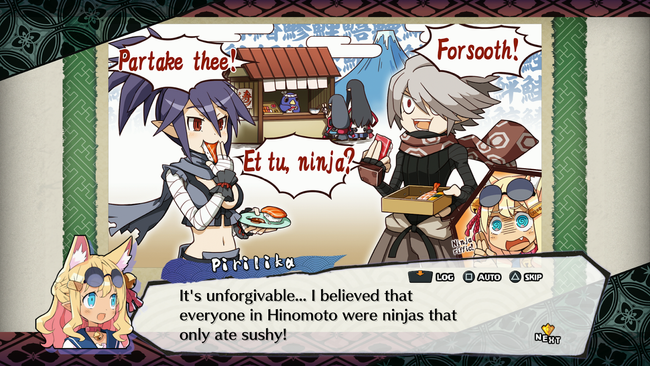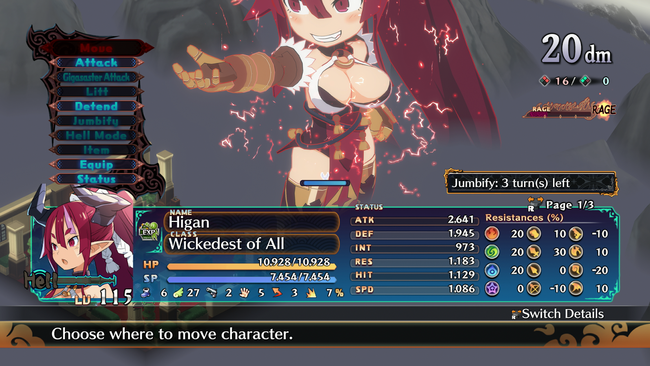
Disgaea 7: Vows of the Virtueless Review
With any series that manages to reach the point in its life where it can slap a seven next to its title, there may be concerns that the series is just “more of the same”. While there can (and should) be discussions on whether change is necessary and on what scale, it may be best to work with what you know — changing only what you need based on feedback from previous iterations. Disgaea 7: Vow of the Virtueless does just this, keeping the series true to its roots while offering new and inventive ways to break the game over your knee.
Disgaea, as a series, is chiefly about big numbers and breaking game mechanics. As a tradition, Disgaea games not only allow you to destroy any semblance of balance, they welcome it. Disgaea 7 continues this trend, with multiple systems working with one another to provide massive bonuses to your EXP, HL, or Mana gain. For example, the Dark Assembly allows you to pass bills to, say, gain triple experience or siphon all EXP towards a single character. The Cheat Shop returns, allowing you to modify your resource gain at the expense of other resources. Evilities return and work as they have since Disgaea 5, allowing you to slap on as many +EXP, HL, or Mana Evilities as you can fit on your roster. All of these systems, and more, weave together and allow you to funnel as much or as few resources any which way. But all of this is expressly outlined in the demo — tips and tricks for powerleveling units up past level 100 in the demo are floating around the internet — so we’ll move on to what the demo doesn’t have.

The story in Disgaea 7 is a surprisingly funny tale about a family, both found and related, coming together against a corrupt government that is bleeding the land dry. The game takes place in Hinomoto, which is a Netherworld version of Japan, and features a primary cast including Fuji, a demon swordsman who is allergic to empathy (no, literally, he vomits blood anytime someone is nice), and Pirilika, an extremely rich weeaboo who loves Hinomoto and its culture — and almost immediately tells on herself, showing that she has a surface-level understanding of the place she loves by mispronouncing words and wondering why old cultural hegemonies, like bushido, no longer exist.
Pirilika is a well-written jab at otaku who claim to love Japan, but fail to understand that Japan, like the rest of the world, is more than the simplistic impression presented in pop media. Like Japan, Hinomoto is not just anime and manga, it’s a place with struggles and concerns about everything from employment to wealth inequality — something that Pirilika becomes acutely aware of as the story progresses.
Combined with the rest of the cast (Yeyasu, a puppet shogun installed by a tyrant who is functionally useless, Ceefore, an amnesiac thief who snorts gunpowder daily, Suisen, a cybernetic weapon that can predict the future and Higan, a warrior demon who remains undefeated and whose rage cannot be quelled, except by sweets), and you have a colorful cast of characters that all share the limelight and never really outshine one another.

While the main cast of characters is pretty fun to be around, it’s worth noting that this is still a Disgaea game, and Disgaea games have a specific, shall we say, type of humor that is hit-or-miss depending on who plays it. While there is less of the raw and raunchy humor than I expected (this is the series that spawned an action-platformer named Dawn of Operation Panties, Dood! after all) you still have more than a little perverted humor inherent to the series.
In addition to the main cast, you also have the ability to create your own fighters and customize them how you please. Disgaea features a whopping 45 character classes, with the bulk of them needing to be unlocked via Quests. While most of these are returning classes from previous entries, there are four new classes: The Big Eye, which is a demon that excels at lowering stats, the Bandit, a unit that can spawn a Treasure Chest randomly when defeating an enemy, the Maiko, a unit that deals damage against male units more easily, and the Zombie Maiden, a really annoying monster that can regenerate to life after being killed.

Combat in Disgaea is your standard turn-based tactical fare, with your strike team of units moving and positioning on a battlefield against the enemy. Geo Panels, squares that affect battle based on objects that grant stats like -50% DEF or No Ranged Attacks, are also present, and effectively used in some story stages. One stage, in particular, featured a long hallway littered with Geo Panels that prevented ranged attacks, which necessitated strategic movement so that my units didn’t get sniped by the enemy (who had no such restriction).
Some new combat features have been added in Disgaea 7 as well. Hell Mode, which is a super attack that can be unleashed after building up a gauge by fulfilling specific objectives, can be used by the main cast to change the tide of battle. All of these effects are game-changing — Higan’s, for example, allows her to act twice in one turn, while Yeyasu’s allows him to mind-control enemies for a few turns.
Another new feature is Jumbification, which allows a unit to multiply their size and strength, and occupy one side of the field of battle. A Jumbified unit not only can strike anywhere on the battlefield in a wide AoE, but it also carries unique effects depending on who you Jumbify. Pirilika, for example, has a flat 10% chance to put enemies to sleep upon striking them, while a Jumbified Prinny gives everyone the passive Prinny effect — meaning every unit on the field can now be thrown and exploded like a Prinny, dood.

However, while experimenting with the combat changes, I did notice a small problem — depending on the map background and how many Jumbified units you have (a maximum of four), the game can and does experience hitching and FPS drops on PlayStation 5. This was surprising, since the rest of the game runs pretty smoothly, even during the combat cutscenes, which tend to have a lot of flashy effects.
The music is quite nice to listen to, although you hear the same four battle tracks until you reach Chapter 11, which did bother me a little bit. It’s a good combination of traditional Japanese and modern instruments — one battle track features a dual shamisen and electric guitar piece that sounds extremely sick, for lack of a better phrase. Many sadder cutscenes feature an orchestral backdrop centered around what sounds like traditional flutes, which fit well with the narrative theme of the story.
Earlier, I alluded to the fact that Disgaea 7 revels in “breaking the game over your knee”, via interlocking systems like the Dark Assembly, Squad Formation, and Cheat Shop. In addition to returning systems like those, a new one has been added as well — Item Reincarnation, which allows you to transfer properties of one item to another. A Sword fashioned from Shoes will still grant movement speed increases, or a Gun crafted from a Consumable will still be edible, for example. In practice, this means that if you find a weapon that comes with a rare passive, you can transfer that down a chain of items and forge some incredibly powerful gear for your team, combining stats in a way that wasn’t possible in the series until now. You have to fully clear the item’s Item World each reincarnation, but it’s well worth doing.
All of that is to say that if you liked previous Disgaea games — grinding your levels up to max, performing increasingly higher damaging attacks, and seeing a mass of numbers fill your screen — Disgaea 7 continues that trend and amplifies it further. Combined with genuinely funny dialogue, a pretty good story, and a customization ocean that is as deep as it is wide, you have a game that can hoover up no small amount of time out of your day. More of the same isn’t necessarily a bad thing, and Disgaea 7 proves that axiom easily.